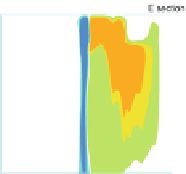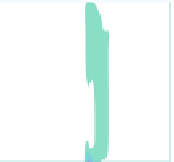Civil Engineering Reference
In-Depth Information
Fig. 5.2 12-turbine OWF effect on ocean velocity components after 24 h of operating wind
turbines. The effect is presented for (a1)-(a3)
u
-component, (b1)-(b3)
v
-component, (c1)-(c3)
w
-
component in the horizontal at surface (a1, b1) and in 2-m depths (c1) and along W-E (a2-c2) and
S-N (a3-c3) cross sections through the OWF, which are marked with
solid lines
in the first
domain. The dimension of the vertical component w is 3.78 m/d, which leads to an overturning
after 15.89 days. Thermocline is defined in 12-m depths (
dotted line
in a2/c3-c2/c3) and the OWF
is placed in the middle of the model domain around
x ¼ y¼
0
Therefore, the most interesting velocity component is the vertical one. On the
basis of the
vertical component w
, a triggered change in ocean dynamics due to the
wind turbines is evident. In the horizontal at the sea surface, a wind farm provokes
two main cells of positive and negative vertical velocity, spanning an area around
the OWF of at least 10
10 grid cells, which means more than 900 km
2
. These
numbers underline a strong impact of wind changes induced within four grid cells,
so an area of 36 km
2
where OWF is placed. The cross section through the model
area from west to east and south to north of component
w
shows that vertical cells
have been established within 24 h. In average, the cells have a size of around
30 km
15 km and are affecting all ocean layers, especially the upper 30 m.
These upwelling and downwelling cells, with a speed of 0.04 mm/s, result in an
overturning after 15-16 days. Even if that duration seems quite long, considering
that in such time range the wind and the number of operating turbines can change,
the induced vertical motion is an important phenomenon, which may also have an
















































































































































































































































































































































































































































































































































































































































































































































































































































































































































Search WWH ::

Custom Search